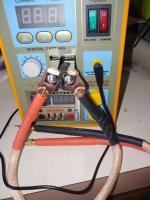I'm a sheet metal worker and know a thing or two about spot welding. I've literally made several hundred thousand spot welds easily. That qualifies me to offer some tips to those not getting optimal results. Here you go...1. Good conductivity at 3 critical points. That is firmly held work pieces pressed tightly together and free and clean of any substance which may hinder conductivity. (I.e, oil, grease, paint, your finger). The tips must also be pressed firmly to the work while the work pieces are making good firm contact to each other.2. A good clean power source and no use of an extension cord of any kind. Doesn't matter. Device plugged into wall outlet fixture. Not some extension strip or janky extension cord. A dedicated circuit is ideal. Your sink disposal and dishwasher are both on dedicated 20's. Your microwave, if not overhead built-in style, should have one as well...by code at lease in the US. Your washer and dryer should both have one. To name a few. Don't use your GFCI circuit. Tripping that device renders it less effective and technically should be replaced after about a dozen trips. Just sayin'. You'll find a few others I didn't mention but don't think you gotta run a home run circuit for this, just use an existing one and swap devices as needed. Meaning don't put a 2 way or 3 way in and think it's ok to share that circuit.3. Make sure all connections are tight and secure and free from conductivity robbing or insulating debris or films.4. Remember what you invested and consider a dinner out with an alcoholic beverage costs more than this thing. The industrial spot welders I am used to using start at about $10k for a decent one. Yes, there are cheaper ones and they remind me of this thing. It will do what you need but you have to set yourself up for success. Or failure. It is what it is. Good luck

